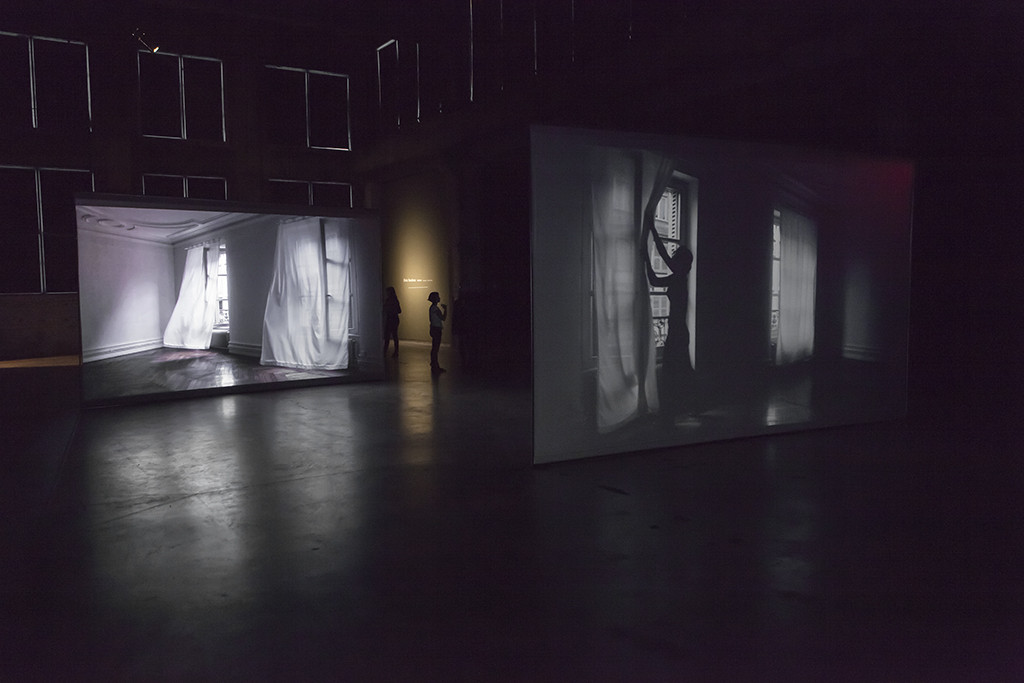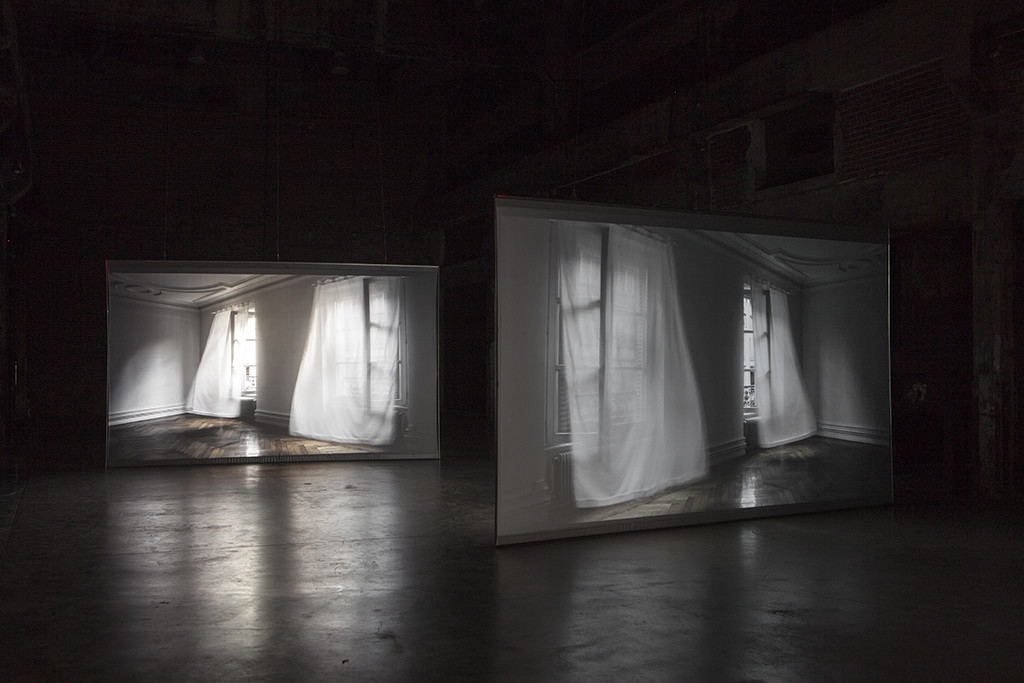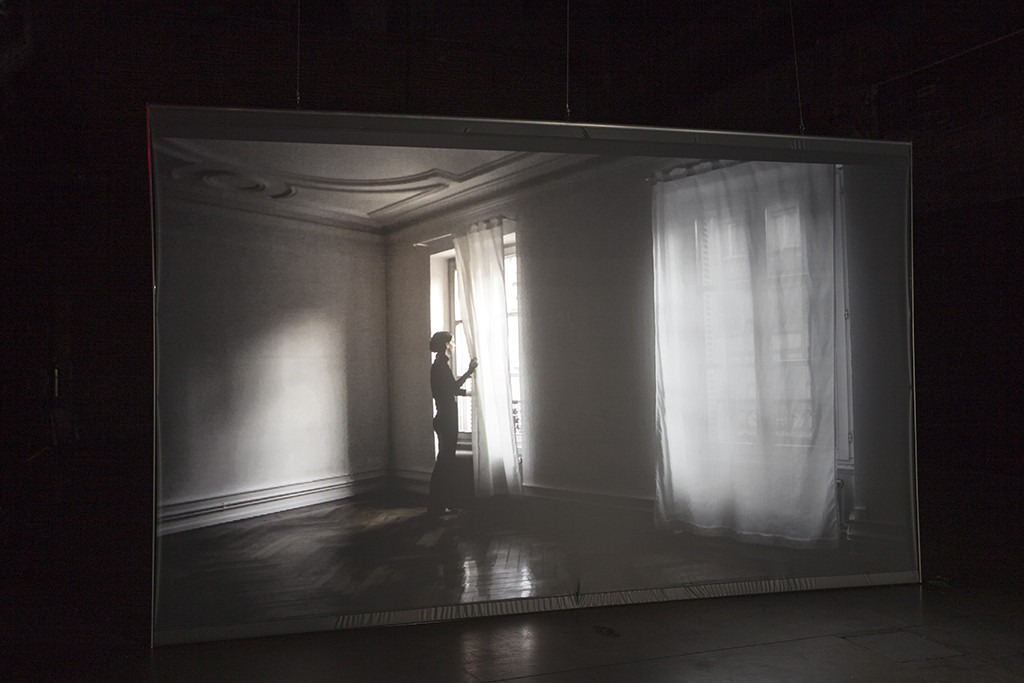


Take the sound of the room breathing
1/at dawn
2/ in the morning
3/in the afternoon
4/ in the evening
5/ before dawn
Bottle the smell of the room of that
particular hour as well.
Yoko Ono[1]
The immaterial and the imperceptible are recurrent themes in artistic practices, especially since the 1960s. The object’s monotony, extreme simplicity, austerity even, still inscribe the works produced along these lines in time as well as is space, on account of two ways in which they relate to visual experience : on one hand, they call for more involvement on the viewer’s part in the guise of a sustained attention to detail ; on the other hand, the time spent looking at an artwork without any action feels longer psychologically than time saturated with action. Olivia Boudreau’s work is entirely coherent with these premises, with slowness and banality as basic features of the way her pieces arise.
Intérieur is a videographic installation involving projection on two screens, set almost in front of each other, to reproduce, in a close, static shot, two windows as seen from inside an apartment[2]. Randomly blown open by the wind in turn, they are then promptly closed by a figure who enters and then leaves the visual field to perform his action. That of Intérieur consists in capturing the opening of the windows, each veiled by a white curtain, as well as the motion of the fabric caught in the draught.
By «magnifying what is terribly ordinary»[3], Olivia Boudreau turns this startlingly banal scene – two windows, two curtains, one figure – into a paradoxically captivating situation that simultaneously involves several features of our perception[4]. With its two screens facing each other and an arrangement of volumes that plays on transparency and superimposition, the installation prompts the viewer to mentally reconstitute the apartment’s room and to appropriate its inner space. Long moments of stillness, framed by closed windows, put us in a state of expectation and steep us in a new temporality, one in which we are forced to remain passive. The opening of one of the windows and the movement of the curtain that is then caught in the wind turn this action into a genuine event. The gauzy, sensual sculpture offering itself up to us makes this liberation all the more exciting[5]. This new temporality is reinforced by various cycles and duplications that give rhythm to the piece. The two identical windows opening one after the other, the two screens showing the same image and arranged symmetrically in space, the figure mechanically performing the same action, the film’s projection in a loop, all work to induce in us a trance that unfolds to infinity, both visually and mentally, detaching us from the material plane and raising our consciousness to other levels.
The absence of colour in a film shot in four colours, the sound of one’s own footsteps echoing in the silent room, the two images with identical framing yet slightly time-delayed action, the roughly parallel yet slightly slanted arrangement of the screens, the subject filmed, the windows —whose function is to open a view on the outside but that occlude it here instead : all are components displaying minimal contents, frustrations and lags, sometimes barely perceptible, that foster our hopes just as much as they limit them, thereby helping us draw from such constraints a way of approaching life.
With this installation, Olivia Boudreau is trying to set up «a device that turns the domestic world into an extension of consciousness»[6]. The simplicity of the room being filmed calls to mind a shrine, offering the spirit a dwelling and conducive to meditation and inner stillness. Chinese philosophers are known for giving great importance to the Void ; for them, it is not, as one might think, something vague or non-existent, but an eminently dynamic and active element, «within which breaths circulate, linking the visible world and the invisible world»[7]. On her part, Olivia Boudreau, who integrates this concept into the majority of her works, wants to «highlight the paradoxes involved in psychic activity» straddling inner and outer, single and double, repetition and oscillation, presence and absence, and immerses us in our own inwardness.
[1] Yoko Ono, Tape piece II, fall 1963, in Grapefruit, original version published in 500 copies by Wunternaum Press in Tokyo, 1964, Section 1 / Music. No pagination.
[2] Intérieur was produced during a residency in Strasbourg, as part of an exchange between Langage Plus, Agence culturelle d'Alsace/Frac Alsace and the CEAAC.
[3] Interview in Art-Apparitions, OVNI 04/2010.
[4] Intérieur cannot fail to remind one of Michael Snow’s work Solar Breath, 2002, currently being shown at the MASS MoCA as part of the Oh,Canada exhibition, May 2012-April 2013. It has inspired the artist a great deal, particularly for Intérieur, 2011 and Le Mur (“The Wall”), 2011.
[5] According to Jean-François Lyotard, «the prospect that nothing might happen is often associated with a feeling of anxiety, but the suspense can also be accompanied by pleasure.» L’Inhumain. Causeries sur le temps. Paris: Galilée, 1988, p. 104.
[6] Interview with Olivia Boudreau by Caroline Andrieux, September 2012.
[7] François Cheng, Vide et plein: le langage pictural chinois. Paris: Seuil, 1991, p. 7.
Olivia Boudreau
Olivia Boudreau is a video artist supported by a number of Montreal institutions and art critics. She holds an MFA from the École des Arts Visuels et Médiatiques at UQÀM, Montréal, and was awarded the 2011 Prix Pierre-Ayot from the City of Montreal. Her main solo exhibitions have been shown at B-312, Dazibao, Optica and Galerie de l'UQAM in Montreal, as well as the Néon gallery in Lyon (France) following a residency in Valence organized by Art3. From 2009 to 2012, she was in residence at Fonderie Darling as part of the Montreal Studio program. In 2014, the Leonard & Bina Ellen art gallery at Concordia University organized a retrospective exhibition of her 10-year long artistic career. In 2012, 2014 and 2016, Boudreau was on the long list of the Sobey Art Award, the most prestigious award in contemporary art in Canada. Her work is represented in the collection of major museums and institutions of Quebec.
